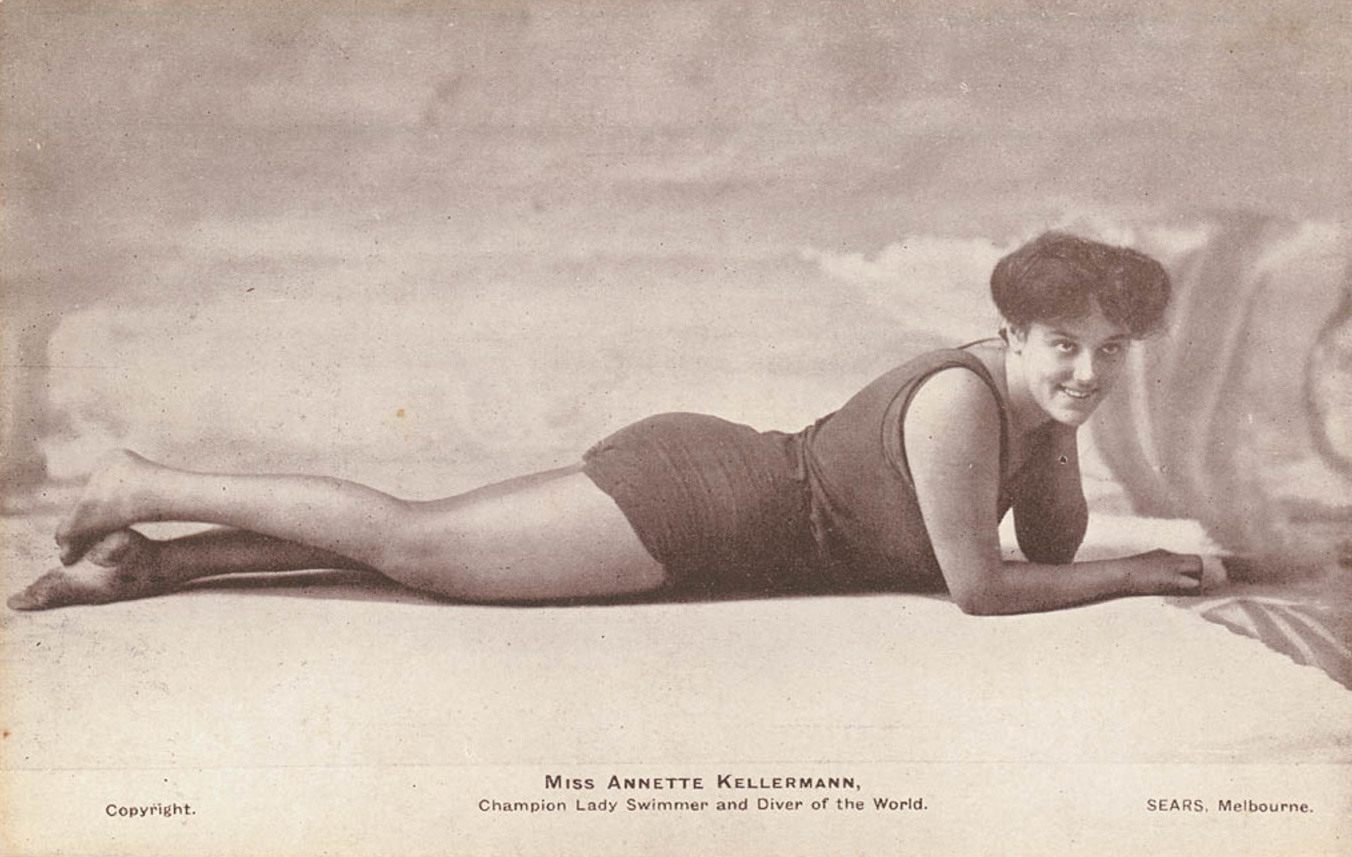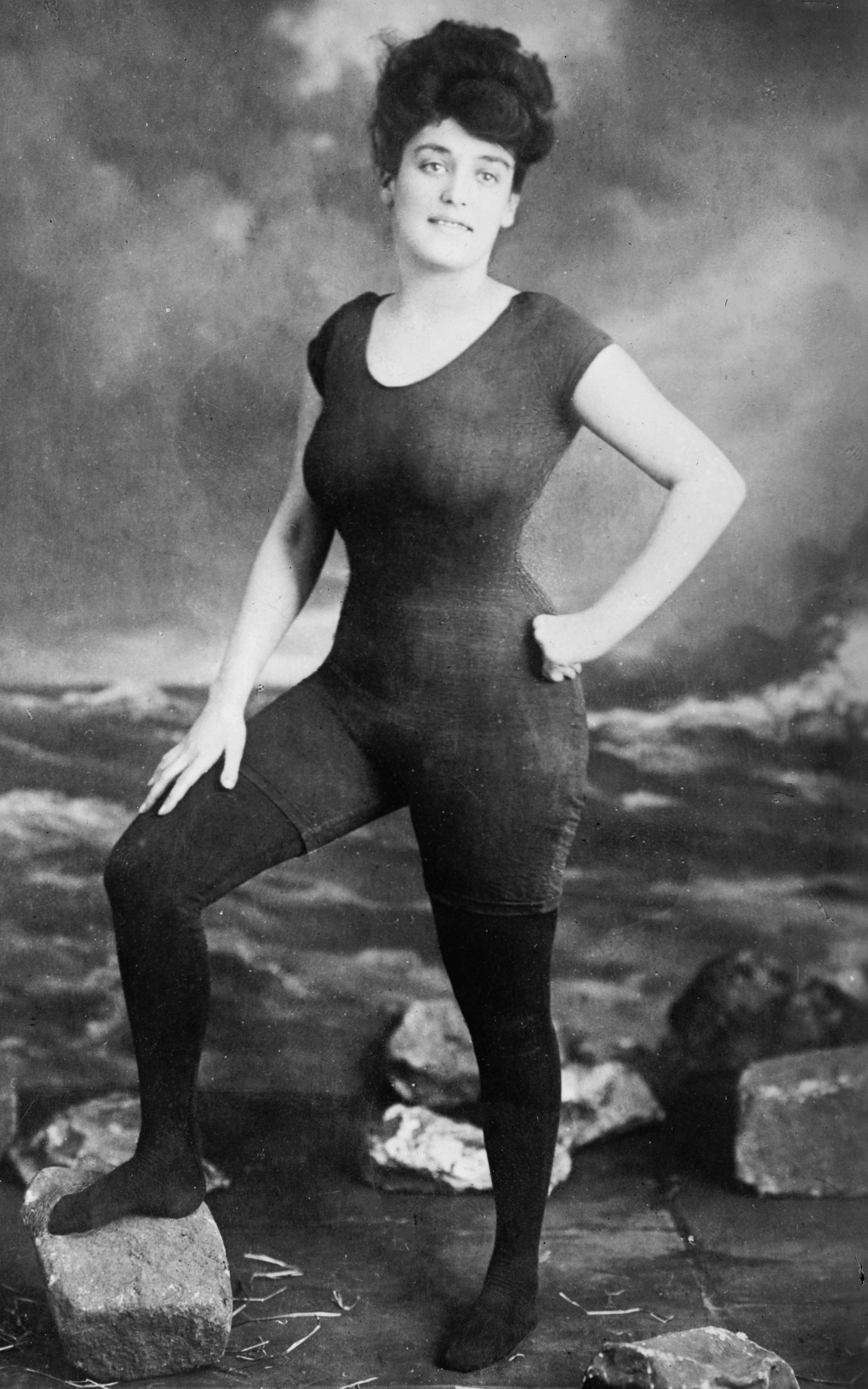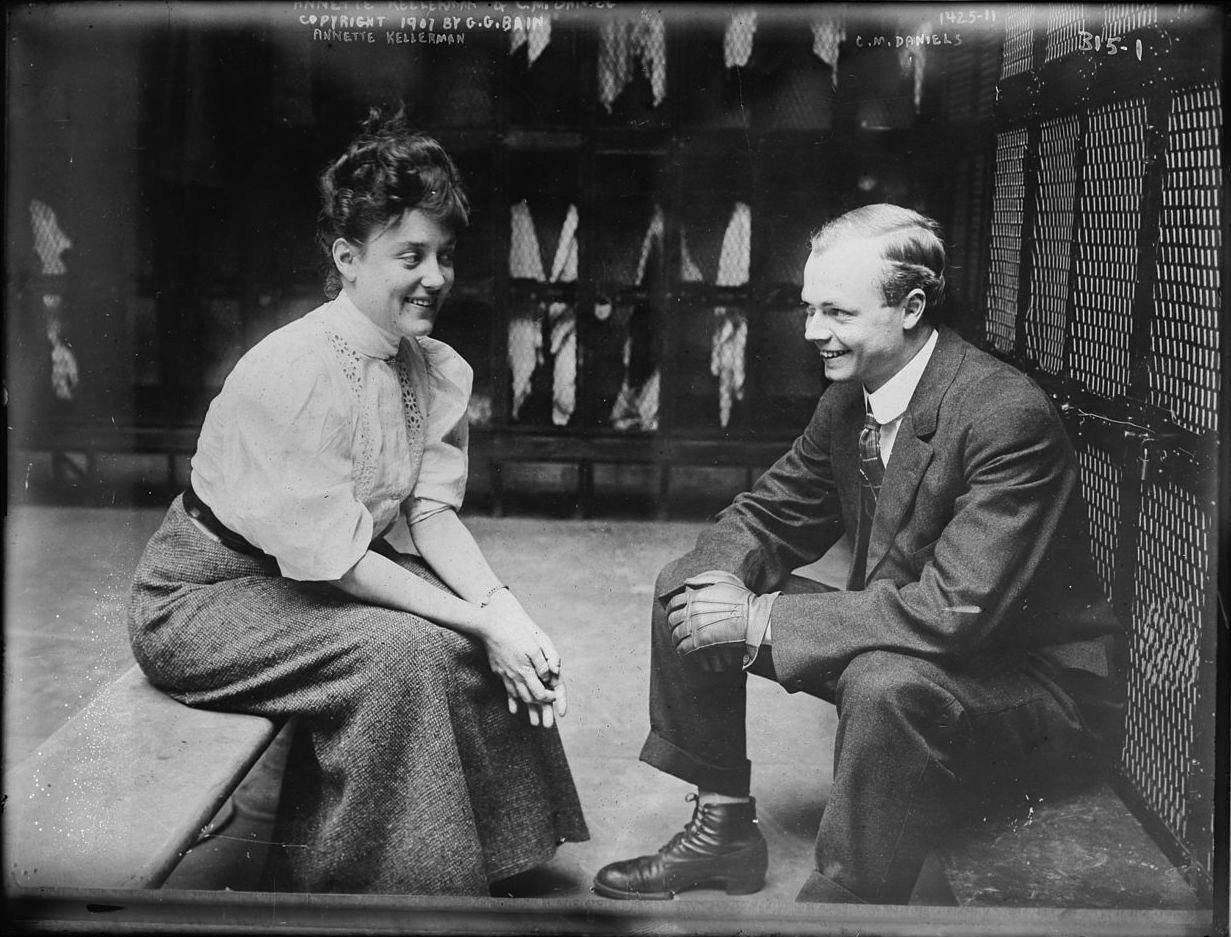The ‘Australian Mermaid’ Who Introduced Recreational Swimming to American Women

Annette Kellerman in one of her more scandalous swimming ensembles. (Photo: State Library of New South Wales)
In the summer of 1907, an Australian woman by the name of Annette Kellerman made a startling appearance on the sands of Revere Beach just north of Boston. Amid the female sunseekers wearing the standard bathing costume of the time—blouse; skirt; stockings; swimming shoes—she strolled toward the water in a short-sleeved unitard cut to two inches above the knee.
For this stunt, Kellerman was promptly arrested for indecent exposure. “She was denounced as a wanton,” reported the New York Times, “and dark prophecies were made as to the future of America.”

The incident, which ended with a judge dismissing Kellerman on the proviso she wear a robe when walking to the water, was just the kind of publicity Kellerman needed on her quest to bring recreational swimming to American women.

A typical turn-of-the-century swimming costume: restrictive, cumbersome, and certainly no good for doing laps. (Photo: Eddowes Bros/Library of Congress)
In 1907, Kellerman was “the world’s most famous woman swimmer and diver,” declared Ohio’s Chronicle-Telegram. Born in 1886 and raised in seaside Sydney, the woman known as the “Australian mermaid” learned to swim during childhood in an effort to strengthen the weak legs she had developed due to poliomyelitis. After discovering she had natural speed and grace in the water, Kellerman began entering swimming races—which at the time were a new and rare thing for women—demonstrating her balletic diving among the fish at the Melbourne Aquarium, and training for long-distance swims.
In 1904, aged 18, Kellerman traveled to Europe, where she promptly flung herself into many of the continent’s most notable rivers. A 26-mile swim in the Thames was followed by a race in the Seine, in which she placed third against 17 male competitors. After winning a 22-mile race in the Danube, she headed to the English Channel. She was intent on swimming across it, starting in southern England and ending in northern France, a feat that had only been accomplished only once, by Matthew Webb in 1875. Coated in porpoise oil and wearing a men’s racing suit, Kellerman made it about three-quarters of the way before having to admit defeat after 10 hours, saying she “had the endurance but not the brute strength.”
Having given distance swimming a solid go, Kellerman switched her focus to vaudeville, becoming a pioneer of the underwater ballet moves now seen in synchronized swimming, Weeki Wachee, and aquatic incarnations of Cirque du Soleil. In 1905 she began performing at the London Hippodrome, which earned her an invitation to showcase her mermaid skills at a private event for the Duke and Duchess of Connaught. For this event, Kellerman was not permitted to wear the leg-revealing men’s swimsuit she had grown accustomed to donning in the more sartorially casual Australia. Improvising, she took her usual suit and sewed stockings onto it, thereby creating the first one-piece swimsuit for women.

Kellerman in her newfangled one-piece swimsuit for women. (Photo: Bain News Service/Library of Congress)
When her season at the Hippodrome ended, Kellerman headed to the United States. Her focus, again, was vaudeville, but along the way Kellerman took up another important mission: to teach American women to swim. A big part of this quest was the issue of the swimsuit. “American women have too long been handicapped in the enjoyment of this excellent sport by silly styles in bathing costumes that make real swimming well-nigh impossible,” Kellerman wrote in her 1918 book, Physical Beauty, How to Keep It.
A few months before her arrest at Revere Beach, Kellerman penned a swimming-focused editorial, published in Ohio’s Chronicle-Telegram. In it she offered recommendations on what to wear in the water: “The best costume is the cheap, ordinary stockinet suit, which clings close to the figure, and the closer the better,” she wrote. “It should be sleeveless, and there should be no skirts…They are very pretty and appropriate for the seaside, but not for the swimming pool.”
At a women-only lecture delivered at the Colonial Theater in New York on November 23, 1909, Kellerman told her audience that “if more girls would swim and dance and care for athletics, instead of rushing into matrimony as the only joy in the world, there would be fewer divorces.” Having made this declaration, the ‘Australian mermaid’ stripped off her black velvet gown to reveal a black one-piece swimsuit, and jumped into a water tank to demonstrate her aquatic agility. A Cincinnati Enquirer report on the evening noted that “many a woman went away vowing to learn to swim if she had to break ice to do it.”

Champion swimmer Rose Pitonof models the daring Kellerman swimsuit style in 1910. (Photo: Bain News Service/Library of Congress)
Over the ensuing decades, Kellerman lived multiple lives in parallel—vaudeville performer; silent film star; author—but they all centered on swimming. This mix of athletics and the arts was not entirely unusual at the time—another champion long-distance swimmer, Rose Pitonof of Massachusetts, was headlining vaudeville shows circa 1910—but Kellerman’s particularly fetching fusion of swimming and entertainment had a beguiling appeal. “The average genius in athletics or the arts is apt to be a frump,” wrote an Oakland Tribune reporter in 1908. “Miss Kellerman escapes this charge; she is gifted with both beauty and style.”
The totally non-frumpy Kellerman was so fetching that in 1905 she even garnered a marriage proposal while spluttering across the English Channel covered in porpoise grease. An accomplished male swimmer who was splashing alongside her to keep pace lasted a mere half-hour in her shining presence before he turned to her and proposed.
“I told him I preferred waiting until I saw him out of the water,” Kellerman said in 1907. Having re-encountered him at a supper given in her honor, she discovered he was “of short stature, so I declined his flattering offer.”

Kellerman and fellow distance swimmer C.M. Daniels in 1907. (Photo: G. G. Bain/Library of Congress)
Looks were important to Kellerman, but her approach to beauty was influenced by the expectations that had been placed on her. In 1910, Dr. Dudley Allen Sargent, director of the Harvard University Gymnasium, dubbed her “the perfect woman,” having run a tape measure around every part of her body, and concluding that her measurements corresponded almost exactly to those of the Venus de Milo, the famous ancient Greek statue. Kellerman’s water ballet shows were subsequently promoted using that “perfect woman” tagline, often alongside a detailed list of her measurements. Apparently a female performer’s wrist circumference was of scintillating interest to Edwardian theatergoers.
Perhaps the most appealing aspect of Kellerman’s legacy is the way in which she acknowledged the desire for, and appeal of, beauty while advocating female strength, confidence, and self-determination. Swimming was her solution, and she was determined to convince American women of its merits. In a 1907 newspaper column she even provided swimming lessons for readers who didn’t live near water, advising them to “perfect the rudiments of the essential stroke” by lying prone on a chair “in one’s own boudoir,” extending the arms and legs, and flailing them elegantly until tired. (If that seemed too daunting, Kellerman advised the reader to “throw one’s self first across the bed” and try the leg-arm wiggling there.)
“I insist that swimming is not only a splendid sport for women, but that it is the sport for women,” she wrote in Physical Beauty, How to Keep It. Not only did she deem swimming the one factor ”to which, more than any other thing, I owe my personal development and success in life,” she declared it “more beneficial to the complexion than all the skin lotions that were ever invented.”



![Anne Bonny and Mary Read were both "convicted of piracy at a Court of Vice Admiralty [and] held at St. Jago de la Vega on the Island of Jamaica, 28th November 1720," according to the inscription accompanying this 1724 Benjamin Cole engraving from <em>A General History of the Pyrates</em>, by Daniel Defoe and Charles Johnson.](https://img.atlasobscura.com/5_kDHgENxQkc0QzZuPs_kICvmEP5JNCV8bcXDI7m5Do/rs:fill:600:400:1/g:ce/q:81/sm:1/scp:1/ar:1/aHR0cHM6Ly9hdGxh/cy1kZXYuczMuYW1h/em9uYXdzLmNvbS91/cGxvYWRzL2Fzc2V0/cy81NDQ0ZGNiMi1m/YzRkLTQ4YjUtYTVh/MC0xYzU2ZDliOTY0/YjY1NGNkMWI4MWEw/OTExMDM5ZTZfQW5u/ZSBCb25ueSBhbmQg/TWFyeSBSZWFkIC0g/RmVtYWxlIFBpcmF0/ZXMgaW4gMTgwMHMu/anBn.jpg)








Follow us on Twitter to get the latest on the world's hidden wonders.
Like us on Facebook to get the latest on the world's hidden wonders.
Follow us on Twitter Like us on Facebook